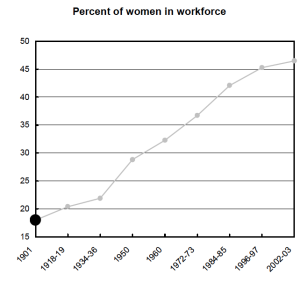Aaron the Aaron and few other e-mail correspondents question my claim (made in this post earlier today) that the higher real household incomes of Americans today, compared to 1975, is evidence of genuine economic improvement for middle-class and even poor Americans. These correspondents insist that these household-income gains are overwhelmingly the result of women entering the workforce and, therefore, do not signal any real improvement in the economic well-being of the typical American individual. The argument is that women entered the workforce because it was harder to make household ends meet on one salary once real wages allegedly started stagnating in the mid-1970s.
I hope soon to offer a longer post on this important and interesting topic. But I want here to make one quick observation: if real wages really did start to stagnate in the mid-1970s (as is often claimed) – and if this wage stagnation obliged women to enter the workforce in order to keep ordinary households economically solvent – then we’d expect to see evidence of an increased rate of labor-force participation by women starting in the mid-1970s. In fact, though, we don’t see such a thing.
This graph is from page 3 of an interesting May 2006 Bureau of Labor Statistics report entitled “100 Years of U.S. Consumer Spending.”

The trend of women entering the workforce is practically unchanged from 1950 through 1997. This trend, therefore, is not consistent with the assertion that economic survival became more difficult for ordinary Americans in the mid-1970s (or early 1980s). Indeed, to get more detailed, this trend actually slows just a bit starting in 1984-85, and then slows even more noticeably between 1996-97 and 2002-03.



